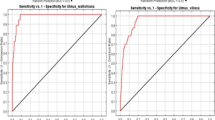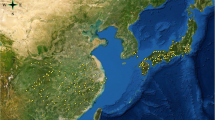Abstract
Prediction of potential geographic distributions is important for species protection and habitat restoration. Ulmus lamellosa is an endangered and endemic species in China for which conservation efforts are required. The maximum entropy (MaxEnt) model was used to predict the current and future geographic distribution (from 2030 to 2070) of U. lamellosa in China and discuss the reasons for changes in climatic suitability. The MaxEnt model provided a good fit to our data as confirmed by an AUC value of 0.948. The suitable areas for U. lamellosa were primarily projected in the northern part of China from 2030 to 2070, especially in Liaoning province. The variables “temperature seasonality”, “precipitation of wettest month” and “precipitation of warmest quarter” were the most influential climatic variables in limiting the distribution of U. lamellosa. Our results clearly predict the future impacts of climate change on the geographic distribution of U. lamellosa and this can help prioritize design of localized conservation strategies in China.






Similar content being viewed by others
References
Adhikari D, Barik SK, Upadhya K (2012) Habitat distribution modeling for reintroduction of Ilex khasiana Purk., a critically endangered tree species of northeastern India. Ecol Eng 40:37–43
Baldwin RA (2009) Use of maximum entropy modeling in wildlife research. Entropy 11:854–866
Bi RC, Zhang J, Su JX (2002) Ecological characters of rare-endangered plant Ulmus lamellosa in Shanxi Province. J Plant Res Environ 11:45–50 (in Chinese)
Bi RC, Yi WB, Wang YN (2003) Study on niche of population of Ulmus lamellosa in the south area of Shanxi province. Acta Bot Boreal Occident Sin 23:1266–1271 (in Chinese)
Busby JR (1991) BIOCLIM—a bioclimate analysis and prediction system. In: Margules CR, Austin MP (eds) Nature conservation: cost effective biological surveys and data analysis. CSIRO, Canberra, pp 64–68
Carpenter G, Gillison AN, Winter J (1993) DOMAIN: a flexible modelling procedure for mapping potential distributions of plants and animals. Biodivers Conserv 2:667–680
Chen HY, Huang CJ (eds) (1998) Fagaceae, Ulmaceae and Rhoipteleaceae. In: Flora of China. Science Press, Beijing, pp 334–350 (in Chinese)
Elith J, Leathwick JR (2009) Species distribution models: ecological explanation and prediction across space and time. Ann Rev Ecol Evol Syst 40:677–697
Fielding AH, Bell JF (1997) A review of methods for the assessment of prediction errors in conservation presence/absence models. Environ Conserv 24:38–49
Franklin J, Wiser SK, Drake DR, Burrows LE, Sykes WR (2006) Environment, disturbance history and rain forest composition across the islands of Tonga, Western Polynesia. J Veg Sci 17:233–244
Gelviz-Gelvez SM, Pavón NP, Rangel PI, Barrera CB (2015) Ecological niche modeling under climate change to select shrubs for ecological restoration in Central Mexico. Ecol Eng 74:302–309
Gu S, Du C (1994) Relationships between geographical distribution of Ulmus lamellosa and climate in China. J Inner Mong For Coll 16:28–32 (in Chinese)
Guo YL, Wei HY, Lu CY, Zhang HL, Gu W (2014) Predictions of potential geographical distribution of Sinopodophyllum hexandrum under climate change. Chin J Plant Ecol 38:249–261 (in Chinese)
Guyon I, Saffari A, Dror G, Cawley G (2010) Model selection: beyond the bayesian/frequentist divide. J Mach Learn Res 11:61–87
Hijmans RJ, Cameron SE, Parra JL, Jones PG, Jarvis A (2005) Very high resolution interpolated climate surface for global land areas. Int J Climatol 25:1965–1978
IPCC (2001) Climate change 2001: impacts, vulnerability and adaptation. Contribution of working group II to the third assessment report of the intergovernmental panel on climate change. IPCC working group 2. Cambridge University Press, Port Chester, New York
IPCC (2014) Climate change 2014: impacts, vulnerability and adaptation. Contribution of working group II to the fifth assessment report of the intergovernmental panel on climate change. IPCC working group 2. Cambridge University Press, Port Chester, New York
Iverson LR, Prasad AM (2001) Potential changes in tree species richness and forest community types following climate change. Ecosystems 4:186–199
Kelly AE, Goulden ML (2008) Rapid shifts in plant distribution with recent climate change. Proc Natl Acad Sci USA 105:11823–11826
Kumar S, Stohlgren TJ (2009) Maxent modeling for predicting suitable habitat for threatened and endangered tree Canacomyrica monticola in New Caledonia. J Ecol Nat Environ 1:94–98
Li GQ, Liu CC, Liu YG, Yang J, Zhang XS, Guo K (2012) Effects of climate, disturbance and soil factors on the potential distribution of Liaotung oak (Quercus wutaishanica Mayr) in China. Ecol Res 27:427–436
Liu YX, Wu TW, Guo YF, Yan JH (2007) Prediction research of climate change trends over north China in the future 30 years. Acta Meteorol Sin 65:45–51 (in Chinese)
Liu L, Chen W, Zheng X, Li J, Yan DT, Liu L, Liu X, Wang YL (2016) Genetic diversity of Ulmus lamellosa by morphological traits and sequence-related amplified polymorphism (SRAP) markers. Biochem Syst Ecol 66:272–280
Ma SM, Nie YB, Geng QL, Wang YX (2014) Impact of climate change on suitable distribution range and spatial pattern in Amygdalus mongolica. Chin J Plant Ecol 38:262–269 (in Chinese)
Pearson RG (2007) Species’ distribution modeling for conservation educators and practitioners. Synthesis. American Museum of Natural History. http://ncep.amnh.org
Pearson RG, Dawson TP (2003) Predicting the impacts of climate change on the distribution of species: are bioclimate envelope models useful? Glob Ecol Biogeogr 12:361–371
Phillips SJ, Miroslav D, Schapire RE (2004) Maxent software for species distribution modeling. http://cs.princeton.edu/∼schapire/Maxent/
Phillips SJ, Anderson RP, Schapire RE (2006) Maximum entropy modeling of species geographic distributions. Ecol Model 190:231–259
Ru WM, Zhang GP, Bi RC, Zhang JT (2007) Population structure and pattern of endangered Ulmus lamellosa in Shanxi. Chin J Appl Environ Biol 13:14–17 (in Chinese)
Stockwell D, Peters D (1999) The GARP modelling system: problems and solutions to automated spatial prediction. Int J Geogr Inf Sci 13:143–158
Swets JA (1988) Measuring the accuracy of diagnostic systems. Science 240:1285–1293
Thompson I, Mackey B, McNulty S, Mosseler A (2009) A synthesis of the biodiversity/resilience/stability relationship in forest ecosystems. Forest resilience, biodiversity, and climate change. Secretariat of the convention on biological diversity, Montreal, technical series no. 43, p 67
Wu HZ, Xu SW, Cui SC (1999) The four new records of plant species in Shanxi province. Shanxi For Sci Tech 2:20–21 (in Chinese)
Wu JD, Wang SL, Zhang JM (2000) A numerical simulation of the impacts of climate change on water and thermal resources in northeast China. Resour Sci 22:36–42 (in Chinese)
Wu ZT, Dijkstra P, Koch GW, Penuelas J, Hungate BA (2011) Responses of terrestrial ecosystems to temperature and precipitation change: a meta-analysis of experimental manipulation. Glob Change Biol 17:927–942
Yang XQ, Kushwaha SPS, Saran S, Xu J, Roy PS (2013) MaxEnt modeling for predicting the potential distribution of medicinal plant Justicia adhatoda L. in Lesser Himalayan foothills. Ecol Eng 51:83–87
Zai XM, Qin P, Wan SW, Zhao FG, Wang G, Yan DL (2009) The application of beach plum (Prunus maritima) to wasteland vegetation recovery in Jiangsu Province, China: seedling cloning and transplantation. Ecol Eng 35:591–596
Zhao CY, Nan ZR, Cheng GD, Zou SB, Zhang YZ (2008) Prediction of the trend of the future climate change in Northwestern China by statistical down scaling. J Lanzhou Univ (Nat Sci) 44:12–18 (in Chinese)
Acknowledgements
The authors thank Xin Zheng for her assistance with field sampling.
Author information
Authors and Affiliations
Corresponding author
Additional information
Project funding: This work was supported by the Shanxi Natural Science Foundation (2015011069) and the University Innovation program of Science and Technology of Shanxi Province (20161109).
The online version is available at http://www.springerlink.com
Corresponding editor: Tao Xu.
Rights and permissions
About this article
Cite this article
Yan, D., Chen, W., Liu, L. et al. Change in current and future geographic distributions of Ulmus lamellosa in China. J. For. Res. 29, 1147–1156 (2018). https://doi.org/10.1007/s11676-017-0503-7
Received:
Accepted:
Published:
Issue Date:
DOI: https://doi.org/10.1007/s11676-017-0503-7




